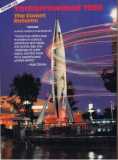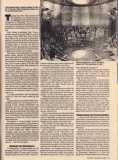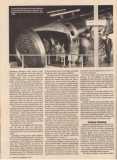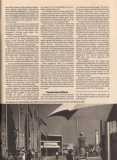The year was 1955. The occasion was the dedication of Tomorrowland, the highlight of the Grand Opening Ceremonies at Disneyland. The future that Walt Disney described in bis dedication was no longer just a dream; it was standing right behind him, a bold reality in the California sun.
Walt Disney proclaimed that Tomorrowland was set in the year 1986,31 years in the future. Why 1986? Well, back in 1910, when Disney was a youngster in Marceline, Missouri, perhaps he stood on a Main Street just like the one at Disneyland, looking up at a brilliant glow in the sky—the glow of Halley's Comet. Standing there, he may have wondered just what kind of world the comet would see on its next visit to Earth.
Years later, when Disneyland was taking shape, Disney recalled his boyhood Main Street and made it the symbol of America's past. In the same way, Tomorrowland was to be the symbol of America's future, set in the year of the comet's return. The year 1986 would form the perfect link between the future and the past.
And what would the comet see when it returned? In Disney's vision, the future of 1986 would be a time of automation, of leisure, of limitless opportunity. Anything we dreamed could be created; as long as we made it out of aluminum! We would be able to fly to the Moon on giant rocket ships, travel the freeways of the future in sleek new sportscars, and sail the seas in plastic boats. To help make sure that all our dreams came true, we would have an unlimited supply of energy, just for us.
Let's take a trip back to 1955 and relive the visions of what our world would be like today.
Tomorrowland was conceived with the unbridled optimism of a thriving post-war industrial society. Dwight Eisenhower was president, and the economy was in good shape. Society was clean, simple and predictable. Boys wore slacks, girls wore skirts, and Mom dried the laundry on a line in the back yard. The medium of television had arrived, opening up a whole new world in glorious black and white.
Everything in Tomorrowland reflected those dreams of optimism. At its entrance, the Clock of the World ticked off the time of day in every country, watching and waiting as the future inched ever closer. Atop the buildings, giant red and white antennae reached out in anxious anticipation of distant signals. Huge helium balloons floated high above and the flags of every country waved overhead. Everyone's attention was turned to the sky . . . and out into space.
Rocket to the Moon
Towering above Tomorrowland was the gleaming, 80-foot tall TWA Moonliner – a stunning symbol of those space frontiers. Steam poured from the rocket's vents as it stood on its launch pad, ready to take would-be astronauts on a flight to the Moon.
As many as 100 guests at a time could enter one of the twin circular space cabins that waited in the building behind the Moonliner. They filed in through the airlocks and seated themselves along the elevated tiers of molded flight chairs. When everyone was ready, Captain P.J. Collins began the countdown. With the powerful thrust of blast-off, the cabin shook, the seats vibrated and the 10-minute journey began.
[…]
Showcase for innovation
A big part of Walt Disney's dream of the future was a Tomorrowland showcase for the innovators of American industry. He believed that the keys for tomorrow were held in the minds of the young and in the soul of private enterprise.
The first of these showcases was entitled "Aluminum in Our Future, " and featured a walking tour through a 40-foot long, all aluminum telescope, where visitors could discover "the brightest star in the world of metals." Murals and sculptures told the "aluminating" story of this wondrous metal – holding forth "the great promise of better living with aluminum in the future."
[…]
Future visions
Making its world premiere in 1955 was Circarama, the ultimate extension of the widescreen movie – it was so wide, it wrapped all the way around the room. Inside the circular theater, guests were surrounded by an 11-screen film that took them on a scenic tour of the western United States, from the Grand Canyon in Arizona to Newport Beach in California. Since the attraction was sponsored by the American Motors Corporation, the accent in Circarama was on the syllable "car" – the 11 cameras used in the filming were actually mounted on the roof of one of American's Rambler station wagons.
[…]
Tomorrow Fillers
Exploring the future can be an arduous task. And when Tomorrowland's explorers ran out of energy, they fueled up at one of its two futuristic fast food stands. The first of these was going to be called the Stratosnak, a fully-automated out-of-this-world restaurant. But by the time it opened, the Stratosnak had become the Space Bar, and, except for some vending machines along each side, it was just another hamburger stand.
[…]



